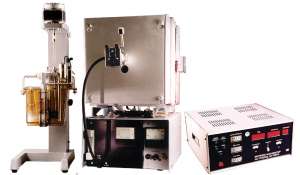Carbon analysis methods (determination of carbon content in alloys)
Carbon in steels and alloys is analyzed by various methods: the OES100 spark optical emission spectrometer or the combustion method with an infrared analyzer. Also carbon can be analyzed by X-ray fluorescence spectrometer, laser optical emission spectrometer and other methods.
А carbon analyzer AN-7529

Express analyzer for carbon AN-7529 is designed to determine the mass fraction of carbon in steels and alloys by the method of automatic coulometric titration by pH value, for marking analyzes for carbon of products and raw materials of metallurgical and metalworking enterprises.
Express analyzer for carbon AN-7529 is used for analysis in laboratories of enterprises and research institutions of various industries.
The analyzers are designed for continuous round-the-clock operation in factory laboratories at ambient temperatures from 10 to 35C, relative humidity up to 80% and meet the requirements for devices of group 2.
More ...
Hide
Measuring characteristics
Measured carbon concentration ranges: 0.03-9.999%
Certification
Type certificate of measuring instruments No. 5647-00 of the State Register of the Russian Federation.
Effect of carbon on steel properties
Carbon (chemical symbol - C) is a chemical element of the 4th group of the main subgroup of the 2nd period of the periodic system of Mendeleev, serial number 6, the atomic mass of the natural mixture of isotopes is 12.0107 g / mol.
With an increase in the carbon content in the steel structure, the amount of cementite increases, while the proportion of ferrite decreases. A change in the ratio between the components leads to a decrease in ductility, as well as to an increase in strength and hardness. The strength increases to a carbon content of about 1%, and then it decreases, as a coarse network of secondary cementite is formed.
Carbon affects the viscous properties. An increase in the carbon content increases the cold brittleness threshold and decreases the toughness.
Electrical resistance and coercive force increase, magnetic permeability and magnetic induction density decrease.
Carbon also influences technological properties. An increase in carbon content worsens the casting properties of steel (steels with a carbon content of up to 0.4% are used), workability by pressure and cutting, and weldability. It should be borne in mind that steels with a low carbon content are also poorly cut.
Classification of steels by carbon content
According to the purpose, steel (an alloy of iron with carbon) is divided into the following main groups: structural, tool and steel with special properties.
Structural steels are used for the manufacture of building structures, parts of machines and mechanisms, ship and carriage hulls, steam boilers, and other products. Structural steels can be both carbon (up to 0.7% C) and alloyed (the main alloying elements are Cr and Ni). The name of structural steel may reflect its direct purpose (boiler room, valve, spring-spring, shipbuilding, gun, shell, armor, etc.).
Tool steels are used for the manufacture of cutters, cutters, stamps, gauges and other cutting, impact-stamping and measuring tools. Steels of this group can also be carbonaceous (usually 0.8-1.3% C) or alloyed (mainly Cr, Mn, Si, W, Mo, V). High speed steel has become widespread among tool steels.
Steels with special physical and chemical properties include electrical steel, stainless steel, acid-resistant, scale-resistant, heat-resistant, steel for permanent magnets, etc. Many steels of this group are characterized by a low carbon content and a high degree of alloying.
Examination of metals and alloys
| Service (for 1 sample) | Deadlines | Price without VAT* |
| X-ray fluorescence analysis | ||
| Determination of alloy grade (carbon + alloying + grade) |
up to 10 days | 105 USD |
| Determination of the carbon content (AN-7529, 0.03-99.99) | up to 11 days | 83 USD |
The prices are approved by the director of LLC "In Consulting" 26.11.2025. Deadlines are indicated in working days
For a free consultation, you can use On-line consultation, or call us or write to the messengers.For information about the cost of services go to Tariffs or place Application for Services.








































